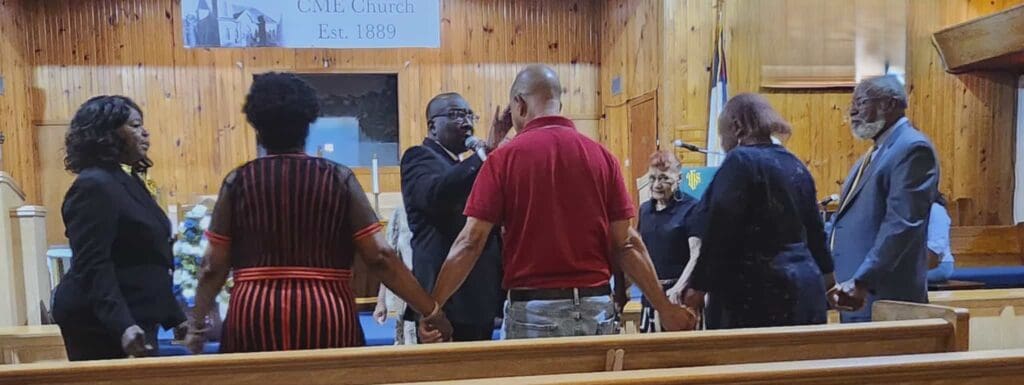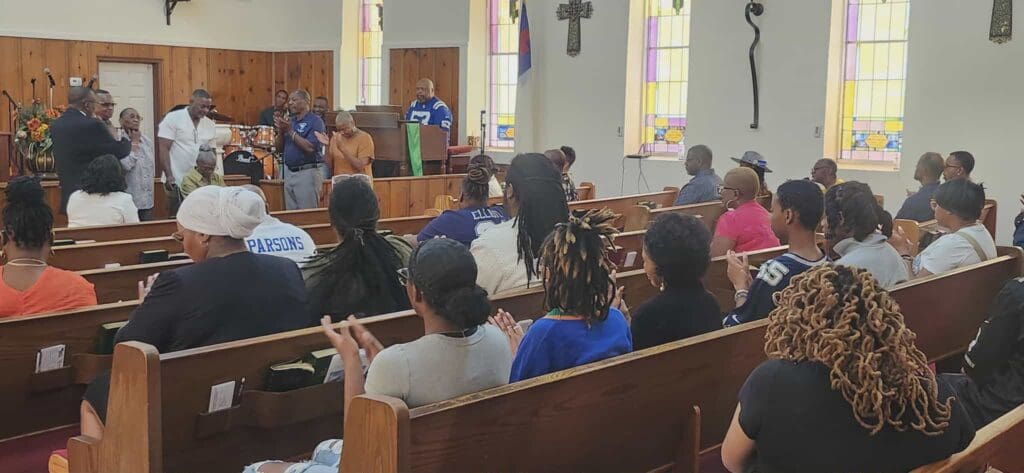Church growth does not happen by osmosis or by simple desire. If that were the case, every congregation would be overflowing with people. As a senior pastor, like many others, I would love to have my congregation filled to capacity every Sunday. I have met several pastors who lead megachurches with a minimum of 1,500 to 2,000 people in worship each week. While this may appear glamorous, research shows that megachurches are rare. Wellman, Corcoran, and Stockly (2020), in their book High on God: How Megachurches Won the Heart of America, note that only about one in two hundred churches in the United States qualifies as a megachurch, which represents less than 1% of all churches. One of my most memorable moments was when I met the late Bishop Gilbert E. Patterson, previous pastor of the Temple of Deliverance Church of God in Christ, a thriving megachurch in Memphis, Tennessee.
He was one of my favorite preachers, and his ministry left an indelible mark on the denomination and the larger Christian community. A couple of colleagues and I attended a Wednesday night Bible Study where more than 2,000 people filled the sanctuary. After the service, we were invited back to his office by a mutual friend. I remember watching as he was escorted off to the side of the pulpit, and moments later, we were ushered into his study. There, he greeted us with a warm smile and genuine conversation about ministry. I knew from our conversation that growing a church to that size took more than him alone. It requires a spiritual principle rooted in collaboration with God, leadership, and his members. No church grows in isolation. When leaders and laity embrace their shared responsibility, the ministry becomes more than just a personality in the pulpit; it becomes Spirit-led.
Paul said it best in 1 Corinthians 3:6 (NIV): “I planted the seed, Apollos watered it, but God has been making it grow.” In other words, we faithfully do the work of ministry, but it is God who brings about real transformation. This is the same principle behind the metaphor of building a house. A blueprint can be drawn, beams can be raised, and when a builder completes the structure, the building may stand tall with a solid foundation, but it does not truly come alive until people live in it. I am reminded of this truth every time I hear one of my favorite Luther Vandross songs, “A House Is Not a Home.” The song describes a beautifully constructed house filled with all the right material possessions, but it remains empty until it is filled with love.
 The same is true for the church. Bricks and mortar alone do not make a congregation alive. A sanctuary can be beautifully decorated, with lovely cushion pews, stained-glass windows, and architectural beauty inside and out. But, without the presence of God and the love of His people, it remains just a hollow building. This is an area where many churches have “cracks”. Love is a powerful tool, but it is often overpowered by anger, division, distrust, and unresolved conflict, which can overpower growth even in the most beautiful churches. For a church to truly become “alive,” love must remain at the center. Love opens doors, heals wounds, and makes space for people to belong. Without it, even the most gifted preaching or the most magnificent building will not sustain growth.
The same is true for the church. Bricks and mortar alone do not make a congregation alive. A sanctuary can be beautifully decorated, with lovely cushion pews, stained-glass windows, and architectural beauty inside and out. But, without the presence of God and the love of His people, it remains just a hollow building. This is an area where many churches have “cracks”. Love is a powerful tool, but it is often overpowered by anger, division, distrust, and unresolved conflict, which can overpower growth even in the most beautiful churches. For a church to truly become “alive,” love must remain at the center. Love opens doors, heals wounds, and makes space for people to belong. Without it, even the most gifted preaching or the most magnificent building will not sustain growth.
It is the Spirit of God and the fellowship of believers that transform a church into a living, breathing house of faith. In the church, occupancy is about filling the space with worship, fellowship, service, love, and evangelism. Throughout my years of ministry, both in rural and urban settings, I have often been told by others that I carry a special anointing for growing churches. While I accept this as part of my calling, I recognize that true growth is multidimensional. It flourishes only when it develops spiritually, numerically, relationally, and missionally. These four dimensions breathe life into the congregation, ensuring that the house of God is not just standing, but thriving.
Spiritual Growth: Deepening Roots in Christ
 Spiritual growth is the root system from which every other type of growth springs. Just as a house cannot stand without a strong foundation, the church cannot thrive without deep spiritual grounding. Believers become mature, resilient, and Spirit-led through prayer, Bible study, and obedience. Paul reminds us in Ephesians 4:15–16 that the church grows when its members speak the truth in love and build each other up. One practice I have is fasting regularly, personally and with my family. I also lead the congregations I pastor in the Daniel Fast, a 21-day season of prayer and fasting. It reminds us that our true dependence is on God, rather than on earthly desires. Its impact is twofold: it strengthens individual spiritual growth and strengthens unity within the church. During this season, worship rises with expectancy from hearts hungry for God’s presence.
Spiritual growth is the root system from which every other type of growth springs. Just as a house cannot stand without a strong foundation, the church cannot thrive without deep spiritual grounding. Believers become mature, resilient, and Spirit-led through prayer, Bible study, and obedience. Paul reminds us in Ephesians 4:15–16 that the church grows when its members speak the truth in love and build each other up. One practice I have is fasting regularly, personally and with my family. I also lead the congregations I pastor in the Daniel Fast, a 21-day season of prayer and fasting. It reminds us that our true dependence is on God, rather than on earthly desires. Its impact is twofold: it strengthens individual spiritual growth and strengthens unity within the church. During this season, worship rises with expectancy from hearts hungry for God’s presence.
Dr. Howard Thurman (1949), a scholar and theologian, reminds us in his book Jesus and the Disinherited that authentic faith is born when the church speaks to the “disinherited,” those who live with their backs against the wall. His insight pushes us to see that spiritual growth is not about private piety alone, but about grounding ourselves in a faith that sustains justice, resilience, and love in the face of struggle. For Dr. Thurman, spiritual vitality equips the church to endure and transform society, ensuring that the foundation we build upon is both personal and prophetic. This insight speaks to how, when our relationship with God deepens, it compels us to share that life with others. Spiritual growth creates an authentic, compelling witness that naturally draws others to Christ.
However, when people are not growing spiritually, they often do not see the necessity to invite others along the journey. Without that deep, personal growth, the natural outflow of evangelism and invitation to others is absent. Evangelism, then, becomes the bridge that connects our spiritual growth to numerical, relational, and missional growth.
Numerical Growth: Filling the House with People
 From time to time, my family and I visit different thriving churches to observe how they are reaching people and drawing them into the life of the congregation. As we visited various churches, I noticed a common pattern: their excitement for God. You can see and feel their relationship with Him, especially through those serving in the greeting or hospitality ministry. Their joy is contagious. Their smiles at the door, warm handshakes, or a simple “we’re glad you’re here” was the first sermon visitors hear, long before the pastor begins to preach. We were then immersed in worship experiences that integrated music, technology, and the creative arts. Many of these churches have dynamic worship teams, engaging music, and an atmosphere of celebration that draws people in.
From time to time, my family and I visit different thriving churches to observe how they are reaching people and drawing them into the life of the congregation. As we visited various churches, I noticed a common pattern: their excitement for God. You can see and feel their relationship with Him, especially through those serving in the greeting or hospitality ministry. Their joy is contagious. Their smiles at the door, warm handshakes, or a simple “we’re glad you’re here” was the first sermon visitors hear, long before the pastor begins to preach. We were then immersed in worship experiences that integrated music, technology, and the creative arts. Many of these churches have dynamic worship teams, engaging music, and an atmosphere of celebration that draws people in.
Each week, we welcome new visitors both online and in person at Morning Chapel CME, “The Rock Church,” in downtown Fort Worth, TX, where I have served as pastor for the past eight years. Some have even joined our church family from other states and cities, traveling to worship with us in person and on special occasions. I believe this happens because of our dynamic worship experience and the authentic witness of people openly sharing real testimonies of God’s work in their lives. That kind of genuine faith naturally draws others in and leads to growth. Testimonies are powerful tools for evangelism. The woman at the well (John 4:29) did not preach a sermon; she shared her story: “Come, see a man who told me everything I ever did. Could this be the Messiah?” When believers share their personal stories, it builds trust, curiosity, and hope.
Relational Growth: Strengthening the Household of Faith
The church becomes a true home when relationships are cultivated, not just vertically with God, but horizontally with one another. Dr. Tony Evans (2015) emphasizes the importance of building relationships within the body of Christ in his book Horizontal Jesus. Church growth often begins when pastors take time to build trust and develop relationships with their congregation. During my first few years at a new church assignment, I typically focus on getting to know people on a personal level. I avoid making drastic changes until I have built strong relationships and mutual trust. Once that trust is established, the church can move forward with changes that will help it grow. A part of this process is to create opportunities for relational connection during Sunday morning worship, such as fellowship time that allows members to encourage one another, share testimonies, and build friendships.
Visitors often tell me that they feel the love of God through the kindness of the congregation. Relational growth also happens when members connect outside of Sunday services through small groups, fellowship meals, and ministry involvement, creating a sense of family. When people serve together, they form stronger bonds that foster long-term growth.
Missional Growth: Extending the House Beyond Its Walls
Occupancy does not end inside the church building, it extends into the community and throughout the world. Missional growth means the church is not confined to Sunday services but is actively engaged in serving beyond its walls. It means taking the love of Christ into schools, communities, workplaces, and personal relationships. This includes addressing local concerns, such as food insecurity, health crises, homelessness, and addiction, while also addressing global concerns. Our church participates in worldwide missions, supporting overseas CME congregations and missionaries. This broadens our vision and reminds us that the “House of God” is much bigger than our local sanctuary—it is a global family of faith. Missional growth deepens our sense of responsibility for the worldwide church. When members witness the challenges faced in other parts of the world, their gratitude is deepened and their sense of purpose is renewed.
Strengthening the Framework: Retaining Members for Long-Term Growth

New Member Orientation
If the pews are full but people do not feel valued, or if they sense pressure to conform to a “this is how we’ve always done it” mindset, new members will quickly drift away. Thom S. Rainer (2014) confirms this in Autopsy of a Deceased Church, encouraging churches to honor traditions but refuse to live in them. He warns that clinging to the phrase “we’ve never done it that way before” often blocks growth and keeps congregations stuck in decline. When people know they are essential to the ministry, welcomed as part of the family, and treated as co-builders in God’s Kingdom, the church moves beyond survival and begins to thrive. For many historic congregations, the challenge is not just bringing people through the doors but keeping them engaged once they arrive.
I found that new member care teams are an effective way to retain new members. These teams are made up of seasoned, spiritually mature members who walk alongside newcomers. They are assigned to pray with them, invite them into fellowship, and show them how they can contribute to the ministry. This includes calling, visiting, and introducing new members to the church’s vision, ministries, and history, especially important in the Christian Methodist Episcopal (CME) Church for those who were not born into the denomination. This helps to foster a sense of belonging, trust, and purpose. When people see where they fit and how they can contribute, they are more likely to stay. In this way, as we occupy the mission of God, we become a living, breathing church, a true home where God’s presence dwells and where His people grow spiritually, numerically, relationally, and missionally.
Call to Action
- Commit to Spiritual Growth by deepening your discipleship through prayer, worship, and the Word.
- Commit to Numerical Growth by inviting others to join the fellowship and sharing your testimony.
- Commit to Relational Growth by creating spaces for meaningful connections and showing love to visitors.
- Commit to Missional Growth by serving your community and engaging in global missions.
- Commit to Living the Gospel Daily by carrying Christ’s love beyond the church and into your daily life.
References
Evans, T. (2015). Horizontal Jesus: How our relationships with others affect our experience with God. B&H Publishing Group.
Rainer, T. S. (2014). Autopsy of a deceased church: 12 ways to keep yours alive. B&H Publishing Group.
Thurman, H. (1976). Jesus and the disinherited. Abingdon Press.
(Original work published 1949)
Wellman, J. K., Corcoran, K. E., & Stockly, K. (2020). High on God: How megachurches won the heart of America. Oxford University Press.




